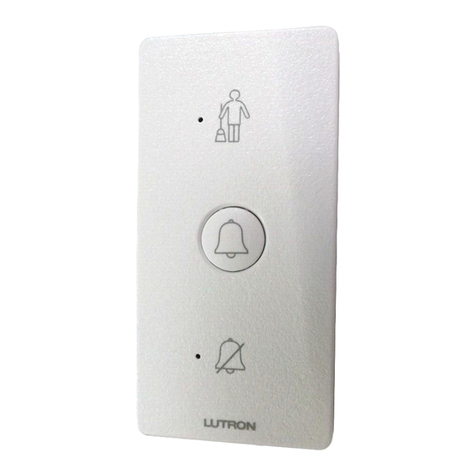
54 Copia para el ocupante Instrucciones de instalaciónInstrucciones de instalación Copia para el ocupante
Configuraciones de cableado permitidas
Cableado/Instalación
•Consulte la guía de instalación del sistema y los diagramas
de trabajo de Lutron para conocer las restricciones
y limitaciones del cable de alimentación y el cableado
de datos (enlace del control).
•Conecte la botonera de pared al enlace del control
dentro de la caja de empotrar de la botonera de pared
o en una caja de conexiones (de otro proveedor).
•Utilice el conector de cable exigido por los códigos locales.
•El cableado del enlace del control no debe correr
en el mismo conducto que la tensión de línea.
•El cable de descarga/blindaje debe ser continuo a lo largo
del enlace de control. No conecte el blindaje a tierra/masa
ni permita que entre en contacto con la caja de empotrar
conectada a tierra.
•No conecte la alimentación de alto voltaje a terminales
de bajo voltaje. Un cableado incorrecto puede causar
lesiones personales o daños al control o a otros equipos.
LUTRON
LUTRON
LUTRON
LUTRONLUTRON
LUTRON
LUTRON
LUTRON
LUTRON
LUTRON
LUTRON LUTRON LUTRON
LUTRON
En serie
LUTRON
LUTRON
LUTRON
LUTRONLUTRON
LUTRON
LUTRON
LUTRON
LUTRON
LUTRON
LUTRON LUTRON LUTRON
LUTRON
Derivación
en T
Cableado del enlace QS
Conecte dos cables de par trenzado y blindado de
0,5mm2(22 AWG) a los terminales 3 y 4 del conector
de enlace del control de la botonera de pared. Los
blindajes (la descarga) de los cables de par trenzado
se deben conectar juntos como se muestra en la
ilustración, pero no conecte el blindaje a tierra/masa ni
a la botonera de pared, ni permita que haga contacto
con la caja de empotrar conectada a tierra.
¡Advertencia! Riesgo de descarga
eléctrica. Puede ocasionar lesiones
graves o la muerte. APAGUE siempre
el cortacircuitos/microcortacircuitos o retire
el fusible principal de la línea de alimentación antes
de realizar cualquier trabajo.
1. Desconecte
la alimentación.
Desconecte la alimentación
en el cortacircuitos/
microcortacircuitos
(o retire el fusible).
2. Monte la caja de empotrar. Asegurar el tamaño
correcto. Vea “Montaje” para más detalles.
3. Prepare las botoneras de pared. Retire la placa
frontal y apártela.
4. Prepare los cables. Pele el aislamiento de los
cables de modo que queden expuestos 10mm
(4pulg) del cable.
ON
OFF
ON
OFF
ON
OFF
10 mm (4pulg)
Tamaños de cable (verifique la compatibilidad en su área)
Longitud del cableado
del enlace QS
Calibre del cable Cable Lutron P/N
Menos de 153m
(500pies) Alimentación (terminales 1 y 2)
1 par de 1,0 mm2(18 AWG) GRX-CBL-346S (sin plenum)
GRX-PCBL-346S (con plenum)
Datos (terminales 3 y 4)
1 par trenzado, blindado de 0,5 mm2(22 AWG)
153 a 610m
(500 a 2 000pies) Alimentación (terminales 1 y 2)
1 par de 4,0mm2(12 AWG) GRX-CBL-46L (sin plenum)
GRX-PCBL-46L (con plenum)
Datos (terminales 3 y 4)
1 par trenzado, blindado de 0,5 mm2(22 AWG)
Longitud de la sección pelada del cable
Cableado de control IEC PELV/
NEC®Class 2
(2) 1,0 mm2(18 AWG)
1: Común
2: 24V
153 a 610 m/500 a 2 000 pies
seeTouch®, seeTouch® Internacional
4
3
2
1
Enlace de datos: (1) par trenzado y blindado
0,5 mm2(22 AWG)
3: MUX
4: MUX
(2) 4,0 mm2
(12 AWG)
(2) 4,0 mm2
(12 AWG)
Signature SeriesTM, ArchitraveTM
1
2
3
4
Enlace de datos: (1) par trenzado
y blindado 0,5 mm2(22 AWG)
3: MUX
4: MUX
(2) 4,0 mm2
(12 AWG)
(2) 4,0 mm2
(12 AWG)
Descarga
Descarga
Cableado de control IEC PELV/
NEC®Class 2
(2) 1,0 mm2(18 AWG)
1: Común
2: 24V
4
3
2
1
1
2
3
4
Descarga
Descarga
Cableado de control IEC PELV/
NEC®Class 2 (2) 1,0 mm2(18 AWG)
1: Común
2: 24V
Enlace de
datos
Enlace de datos
Enlace de datos: (1) par trenzado
y blindado 0,5 mm2(22 AWG)
3: MUX
4: MUX
AC N
099 942 971
CO OPERSBURG , PA 18036 USA
:
30 mA
CO OPERSBURG , PA 18036 USA
:
30 mA
seeTouch®
Signature SeriesTM, ArchitraveTM
4 3 2 1
C B A
seeTouch® Internacional
Cableado de control
IEC PELV/NEC®
Class 2
Descarga
Enlace de datos
Cableado de control
IEC PELV/
NEC®Class 2
Cableado de control IEC PELV/
NEC®Class 2
< 153 m/500 pies
Conecte los cables del tamaño apropiado a las
terminales 1 y 2 para la alimentación, de acuerdo
con la longitud del enlace (consulte la tabla en la
página opuesta).




























